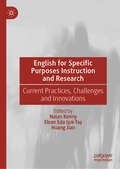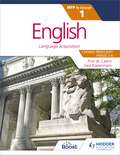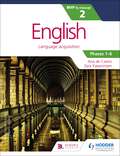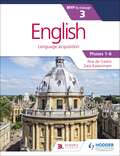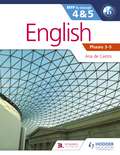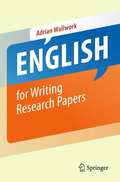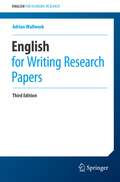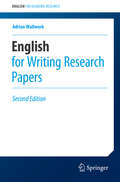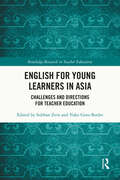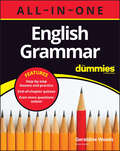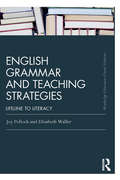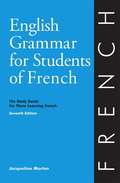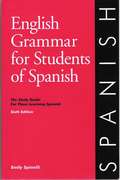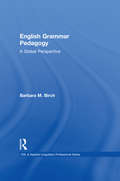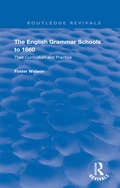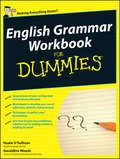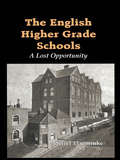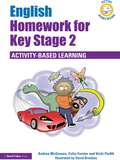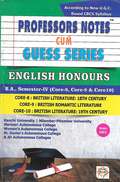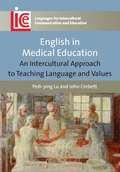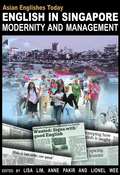- Table View
- List View
English for Specific Purposes Instruction and Research: Current Practices, Challenges and Innovations
by Nalan Kenny Elvan Eda Işık-Taş Huang JianThis edited book focuses on current practices, challenges and innovations in the emerging field of English for Specific Purposes (ESP). By combining diverse, empirically-proven and innovative ESP practices from all over the world with inspiring theoretical input and reflections from experienced practitioners, the authors in this volume examine both best-practice examples and ESP programmes which by various metrics are deemed to have failed. This book will be of interest to practitioners, teacher educators and researchers working in the field of ESP, as well as readers interested in language education and curriculum development more broadly.
English for the IB MYP 1
by Zara Kaiserimam Ana de CastroExam Board: MYPLevel: IBSubject: EnglishFirst Teaching: September 2016First Exam: June 2017Develop your skills to become an inquiring learner; ensure you navigate the MYP framework with confidence using a concept-driven and assessment-focused approach to English presented in global contexts.- Develop conceptual understanding with key MYP concepts and related concepts at the heart of each chapter.- Learn by asking questions with a statement of inquiry in each chapter. - Prepare for every aspect of assessment using support and tasks designed by experienced educators.- Understand how to extend your learning through research projects and interdisciplinary opportunities.
English for the IB MYP 1
by Zara Kaiserimam Ana de Castro Stephanie BarrusExam Board: MYPLevel: IBSubject: EnglishFirst Teaching: September 2016First Exam: June 2017Develop your skills to become an inquiring learner; ensure you navigate the MYP framework with confidence using a concept-driven and assessment-focused approach to English presented in global contexts.- Develop conceptual understanding with key MYP concepts and related concepts at the heart of each chapter.- Learn by asking questions with a statement of inquiry in each chapter. - Prepare for every aspect of assessment using support and tasks designed by experienced educators.- Understand how to extend your learning through research projects and interdisciplinary opportunities.
English for the IB MYP 2
by Zara Kaiserimam Ana de CastroA concept-driven and assessment-focused approach to English language acquisition teaching and learning.- Approaches each chapter with statements of inquiry framed by key and related concepts, set in a global context- Supports every aspect of assessment using tasks designed by an experienced MYP educator- Differentiates and extends learning with research projects and interdisciplinary opportunities- Applies global contexts in meaningful ways to offer an MYP English programme with an internationally-minded perspective
English for the IB MYP 2
by Zara Kaiserimam Ana de Castro Stephanie BarrusA concept-driven and assessment-focused approach to English language acquisition teaching and learning.- Approaches each chapter with statements of inquiry framed by key and related concepts, set in a global context- Supports every aspect of assessment using tasks designed by an experienced MYP educator- Differentiates and extends learning with research projects and interdisciplinary opportunities- Applies global contexts in meaningful ways to offer an MYP English programme with an internationally-minded perspective
English for the IB MYP 3
by Zara Kaiserimam Ana de CastroExam board: International BaccalaureateLevel: MYPSubject: EnglishFirst teaching: September 2014First exams: Summer 2016Develop your skills to become an inquiring learner; ensure you navigate the MYP framework with confidence using a concept-driven and assessment-focused approach to English presented in global contexts.- Develop conceptual understanding with key MYP concepts and related concepts at the heart of each chapter.- Learn by asking questions with a statement of inquiry in each chapter. - Prepare for every aspect of assessment using support and tasks designed by experienced educators.- Understand how to extend your learning through research projects and interdisciplinary opportunities.
English for the IB MYP 3
by Zara Kaiserimam Ana de Castro Stephanie BarrusExam board: International BaccalaureateLevel: MYPSubject: EnglishFirst teaching: September 2014First exams: Summer 2016Develop your skills to become an inquiring learner; ensure you navigate the MYP framework with confidence using a concept-driven and assessment-focused approach to English presented in global contexts.- Develop conceptual understanding with key MYP concepts and related concepts at the heart of each chapter.- Learn by asking questions with a statement of inquiry in each chapter. - Prepare for every aspect of assessment using support and tasks designed by experienced educators.- Understand how to extend your learning through research projects and interdisciplinary opportunities.
English for the IB MYP 4 & 5: MYP by Concept (MYP By Concept)
by Ana de CastroWe are working with the IBO to gain endorsement for the MYP by Concept series.Drive meaningful inquiry for the new framework through a unique concept driven narrative.- Supports every aspect of assessment with opportunities that use the criteria- Gives you easy ways to differentiate and extend learning- Provides a meaningful approach by integrating the inquiry statement in a global context- Develops critical-thinking skills with activities and summative sections rooted in the ATL frameworkAlso coming soon are Teaching and Learning Resources and eTextbooks via Dynamic Learning, our complete digital solution.
English for the IB MYP 4 & 5: MYP by Concept (MYP By Concept)
by Ana de CastroWe are working with the IBO to gain endorsement for the MYP by Concept series.Drive meaningful inquiry for the new framework through a unique concept driven narrative.- Supports every aspect of assessment with opportunities that use the criteria- Gives you easy ways to differentiate and extend learning- Provides a meaningful approach by integrating the inquiry statement in a global context- Develops critical-thinking skills with activities and summative sections rooted in the ATL frameworkAlso coming soon are Teaching and Learning Resources and eTextbooks via Dynamic Learning, our complete digital solution.
English for Writing Research Papers
by Adrian WallworkPublishing your research in an international journal is key to your success in academia. This guide is based on a study of referees' reports and letters from journal editors on reasons why papers written by non-native researchers are rejected due to problems with English usage. It draws on English-related errors from around 5000 papers written by non-native authors, 500 abstracts by PhD students, and over 1000 hours of teaching researchers how to write and present research papers.<P><P> With easy-to-follow rules and tips, and with examples taken from published and unpublished papers, you will learn how to:<P> * prepare and structure a manuscript<P> * increase readability and reduce the number of mistakes you make in English by writing concisely, with no redundancy and no ambiguity<P> * plan and organize your paper, and structure each paragraph and each sentence so that the reader can easily follow the logical build-up towards various conclusions<P> * write a title and an abstract that will attract attention and be read<P> * decide what to include in the various parts of the paper (Introduction, Methodology, Discussion etc)<P> * select from over 700 useful phrases<P> * highlight your claims and contribution<P> * avoid plagiarism and make it 100% clear whether you are referring to your own work or someone else’s<P> choose the correct tenses and style (active or passive)<P>
English for Writing Research Papers (English for Academic Research)
by Adrian WallworkPublishing your research in an international journal is key to your success in academia. This guide is based on a study of over 1000 manuscripts and reviewers' reports revealing why papers written by non-native researchers are often rejected due to problems with English usage and poor structure and content. With easy-to-follow rules and tips, and examples taken from published and unpublished papers, you will learn how to: prepare and structure a manuscriptincrease readability and reduce the number of mistakes you make in English by writing concisely, with no redundancy and no ambiguitywrite a title and an abstract that will attract attention and be readdecide what to include in the various parts of the paper (Introduction, Methodology, Discussion etc)highlight your claims and contributionavoid plagiarismdiscuss the limitations of your researchchoose the correct tenses and stylesatisfy the requirements of editors and reviewers This edition has two completely new chapters covering machine translation and using AI tools (e.g. chatbots, paraphrasers, editing tools) to improve and correct the English of a text. Other titles in this series: Grammar, Usage and Style Grammar, Vocabulary, and Writing Exercises (three volumes) 100 Tips to Avoid Mistakes in Academic Writing and Presenting English for Presentations at International Conferences English for Academic Correspondence English for Interacting on Campus English for Academic CVs, Resumes, and Online Profiles English for Academic Research: A Guide for TeachersAdrian Wallwork is the author of more than 40 English Language Teaching (ELT) and English for Academic Purposes (EAP) textbooks. He has trained several thousand PhD students and researchers from 50 countries to write papers. He edits research manuscripts through his own proofreading and editing agency.
English for Writing Research Papers, 2nd Edition
by Adrian WallworkPublishing your research in an international journal is key to your success in academia. This guide is based on a study of over 1000 manuscripts and reviewers' reports revealing why papers written by non-native researchers are often rejected due to problems with English usage and poor structure and content. <P><P> With easy-to-follow rules and tips, and examples taken from published and unpublished papers, you will learn how to:<P> * prepare and structure a manuscript<P> * increase readability and reduce the number of mistakes you make in English by writing concisely, with no redundancy and no ambiguity<P> * write a title and an abstract that will attract attention and be read<P> * decide what to include in the various parts of the paper (Introduction, Methodology, Discussion etc)<P> * highlight your claims and contribution<P> * avoid plagiarism<P> * discuss the limitations of your research<P> * choose the correct tenses and style<P> * satisfy the requirements of editors and reviewers<P> This new edition contains over 40% new material, including two new chapters, stimulating factoids, and discussion points both for self-study and in-class use.
English for Young Learners in Asia: Challenges and Directions for Teacher Education (Routledge Research in Teacher Education)
by Subhan ZeinIn the first book to concentrate on teacher education for English for young learners (EYL) teachers in Asia, Zein and Butler offer a comprehensive coverage of teacher education by addressing various issues and recent developments such as programme evaluation, knowledge base, practicum, classroom discourse, needs analysis, and policy on teacher education. The world’s rapidly changing political, social, economic, and educational landscapes in the 21st century have been distinctively characterized by an increasing number of children who are learning English globally at younger ages. This book tackles the challenges and complexities surrounding teacher education by examining the policies and practices of primary English language teacher education in a variety of educational contexts, namely Bangladesh, China, Indonesia, Japan, Kazakhstan, Thailand, and South Korea. Using a variety of data collection methods like interviews, reflective journals, and questionnaires, the content delves into the different strategies and initiatives that have been implemented or proposed to improve teacher education. A vital read for academics and students in the fields of early language learning, Teaching English to Speakers of Other Languages (TESOL), Applied Linguistics, Educational Linguistics, English Language Education, and comparative education studies, as well as teacher educators aiming to advance the teaching of English in Asia and beyond.
English Grammar All-in-One For Dummies (+ Chapter Quizzes Online)
by Geraldine WoodsLearn to get your ideas across clearly and correctly—the easy way English Grammar All-in-One For Dummies is packed with everything you need to know to communicate with confidence—in your writing, on standardized tests, at work, on social media, and everywhere else. Strong verbal and written skills can help you get where you want to be, and this easy-to-understand Dummies guide will help you understand the English grammar principles you need to know so you can improve your understanding of basic grammar and punctuation rules, easily identify parts of speech, and communicate more effectively. Learn the basics of punctuation—periods, commas, semicolons, and beyond Write clearer e-mails and messages, or ace the writing section of your test Navigate pronouns and make sure you’re using inclusive language Practice with end-of-chapter quizzes and even more online practiceEnglish Grammar All-In-One For Dummies is an excellent resource for students, professionals, job seekers, non-native-English learners, and anyone who wants to brush up on using this crazy language we call English.
English Grammar and Teaching Strategies: Lifeline to Literacy
by Joy Pollock Elisabeth WallerEnglish Grammar and Teaching Strategies aims to demystify grammar and equip any teacher to teach it in the classroom. Carefully set out for ease of reference, this book covers every aspect of grammar, from nouns, adjectives and verbs to punctuation and prepositions. Each grammatical term is clearly defined and accompanied by varieties of usage and teaching strategies, which can be easily extended according to the age and key stage of the pupil. These strategies are for both spoken and written language and can be used for a whole class, small groups, with those with special educational needs and with EAL learners. Featuring a brand new preface by Jo Shackleton, this Routledge Classic Edition is an indispensable resource for all teachers in both primary and secondary schools.
English Grammar For Students of French (Seventh Edition)
by Jacqueline MortonEnglish Grammar for Students of French (EGSF) is a bridge from English grammar to French grammar. Once you have learned a part of speech or a function as it applies to English, it will be easier for you to understand what is being introduced in your French textbook. Each short chapter is divided into two sections, In English and ln French, both explain the same grammar point and alert you to the similarities and differences between the two languages. You will find step-by-step tools to apply grammar rules and to get from an English structure to a French structure.
English Grammar for Students of Spanish (Seventh Edition)
by Emily SpinelliThousands of students have found this book the ideal way to master and upgrade their Spanish grammar.
English Grammar Pedagogy: A Global Perspective (ESL & Applied Linguistics Professional Series)
by Barbara M. BirchDesigned for ESL and ELT pedagogy courses around the world, this text describes English grammar from a World Englishes perspective. It is distinguished by its focus on the social setting for English as a global language, the latest thinking about grammatical theory, and new theories of how first and second languages are learned and taught. The fundamental premise is that teaching and learning grammar cannot be isolated from the local, regional, and global sociocultural contexts in which the teaching and learning take place. Part I presents different attitudes toward English as a global language and some challenges that learners of English share no matter where they are in the world. Part II is about the features of English that educated speakers consider the most likely and probable in Academic English. Part III describes the flexible and fluid features of English that might be susceptible to change or modification over time. Each chapter includes engaging Study, Discussion, and Essay Questions and Activities.
The English Grammar Schools to 1660: Their Curriculum and Practice (Routledge Revivals)
by Foster WatsonFirst published in 1908, this important work on the history of education traces the development of teaching in English Grammar Schools from the invention of printing up to 1660. It is not a history of the theories of educational reformers as to what should or should not be taught, but a history of the actual practices of the schools, of their curricula and of the differentiated subjects of instruction. The author relies heavily on the textbooks used in schools in the sixteenth and seventeenth centuries, in particular the ‘Ludus Literarius’ of John Brinsley and the ‘New Discovery of the Old Art of Teaching School’ of Charles Hoole, and makes free use of the School Statutes which state the express intention of the Founder as to what was to be taught. The period covered is one of great significance in which the Encyclopaedia of the medieval curriculum was abandoned for the modern practice of the differentiation of school subjects. The new knowledge of the Renaissance and the introduction of critical methods and of close analysis gave students a detailed knowledge which could not be fitted into the rigid confines of the medieval Encyclopaedia, while the invention of printing enormously facilitated the increase and spreading of text books for both teachers and pupils.
English Grammar Workbook For Dummies
by Nuala O'Sullivan Geraldine WoodsEnglish Grammar Workbook For Dummies, UK Edition is grammar First Aid for anyone wanting to perfect their English and develop the practical skills needed to write and speak correctly. Each chapter focuses on key grammatical principles, with easy-to-follow theory and examples as well as practice questions and explanations. From verbs, prepositions and tenses, to style, expressions and tricky word traps, this hands-on workbook is essential for both beginners looking to learn and practise the basics of English grammar, and those who want to brush up skills they already have - quickly, easily, and with confidence. English Grammar Workbook For Dummies, UK Edition covers: Part I: Laying the Groundwork: Grammar Basics Chapter 1: Placing the Proper Verb in the Proper Place Chapter 2: Matchmaker, Make Me a Match: Pairing Subjects and Verbs Correctly Chapter 3: Who Is She, and What Is It? The Lowdown on Pronouns Chapter 4: Finishing What You Start: Writing Complete Sentences Part II: Mastering Mechanics Chapter 5: Exercising Comma Sense Chapter 6: Made You Look! Punctuation Marks That Demand Attention Chapter 7: One Small Mark, a Whole New Meaning: Apostrophes Chapter 8: "Let Me Speak!" Quotation Marks Chapter 9: Hitting the Big Time: Capital Letters Part III: The Pickier Points of Correct Verb and Pronoun Use Chapter 10: The Case of It (And Other Pronouns) Chapter 11: Choosing the Best Pronoun for a Tricky Sentence Chapter 12: Travelling in Time: Tricky Verb-Tense Situations Chapter 13: Are You and Your Verbs in the Right Mood? Part IV: All You Need to Know about Descriptions and Comparisons Chapter 14: Writing Good or Well: Adjectives and Adverbs Chapter 15: Going on Location: Placing Descriptions Correctly Chapter 16: For Better or Worse: Forming Comparisons Chapter 17: Apples and Oranges: Improper Comparisons Part V: Writing with Style Chapter 18: Keeping Your Balance Chapter 19: Spicing Up and Trimming Down Your Sentences Chapter 20: Steering Clear of Tricky Word Traps Part VI: The Part of TensChapter 21: Ten Over-corrections Chapter 22: Ten Errors to Avoid at All Cost
The English Higher Grade Schools: A Lost Opportunity
by Meriel VlaeminkeThe English higher grade schools formed a key part of an expanding 19th-century education system, but they threatened the vested interests of a powerful Establishment bent on reaffirming the status quo. The author analyzes the 1902 Education Act as a retrogressive move by which much was lost.
English Homework for Key Stage 2: Activity-Based Learning (Active Homework)
by Andrea McGowan Vicki Parfitt Colin ForsterEnglish Homework for Key Stage 2 is a unique resource for busy teachers - a selection of ‘pencil-free’, hands-on activities, aligned with the National Curriculum Programmes of Study and with clear links to the topics set out in the PNS Framework for English, that teachers can use as extension activities or give to pupils as homework to do with members of their family or friends. Each of the activities encourages the pupils to learn through discussion and through practical activities utilising everyday resources. Each activity is quick and easy for pupils and teachers to manage, and includes: a learning aim, full, clear instructions and discussion points tasks to foster collaboration and partnership between pupils, parents and teachers photocopiable resources. A refreshing approach for teachers and pupils, these activities will foster enthusiasm for learning and inspire pupils' interest in English.
English Honours BA Sem-IV (Core - 8, 9 and 10) - Ranchi University N.P.U
by Kanhaiya Book Distributorss RanchiEnglish Honour's textbook According to the New Syllabus Based on U.G.C. Model Curriculum Choice Based Credit System (CBCS) for B.A. Sem-IV (Core-8, Core-9 & Core-10) from Ranchi University, Nilambar Pitambar University in English.
English in Medical Education
by Peih-Ying Lu John CorbettThis book addresses recent developments in medical and language education. In both fields, there have been methodological shifts towards 'task-based' and 'problem-based learning'. In addition, both fields have broadened their focus on clinical expertise and linguistic skills to address issues of cultural competence. English in Medical Education responds to these changes by re-imagining the language classroom in medical settings as an arena for the exploration of values and professional identity. The chapters cover topics such as the nature of cultural competence; how to understand spoken discourse in a range of medical settings; the use of tasks and problems in language education for medics; the development of critical skills and the use of literature and visual media in language education for doctors. It will interest everyone teaching English for Medical Purposes.
English in Singapore
by Lisa Lim Anne Pakir Lionel WeeEnglish in Singapore provides an up-to-date, detailed and comprehensive investigation into the various issues surrounding the sociolinguistics of English in Singapore. Rather than attempting to cover the usual topics in an overview of a variety of English in a particular country, the essays in this volume are important for identifying some of the most significant issues pertaining to the state and status of English in Singapore in modern times, and for doing so in a treatment that involves a critical evaluation of work in the field and new and thought-provoking angles for reviewing such issues in the context of Singapore in the twenty-first century. The contributions address the historical trajectory of English (past, present and possible future), its position in relation to language policy and multiculturalism, the relationship between the standard and colloquial varieties, and how English can and should be taught. This book is thus essential reading for scholars and students concerned with how the dynamics of the English language are played out and managed in a modern society such as Singapore. It will also interest readers who have a more general interest in Asian studies, the sociology of language, and World Englishes.
